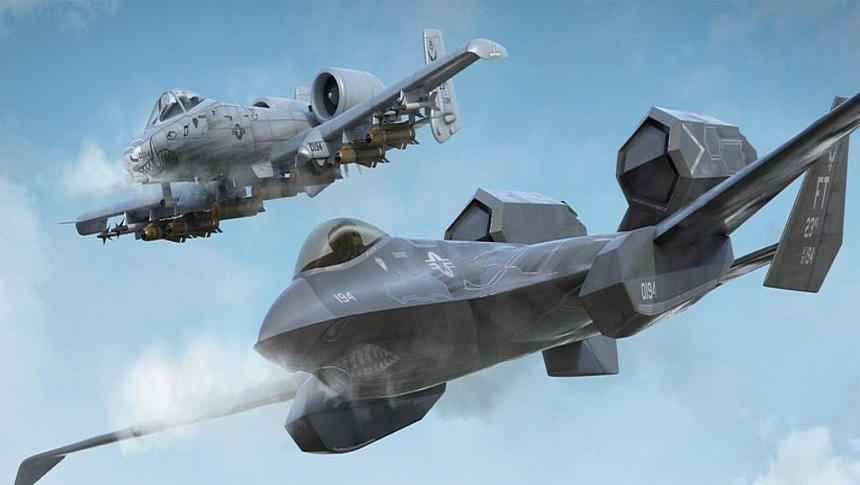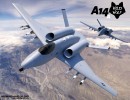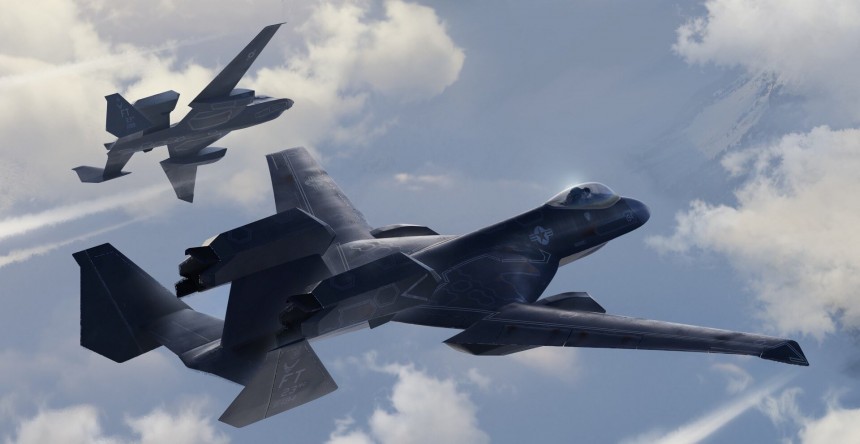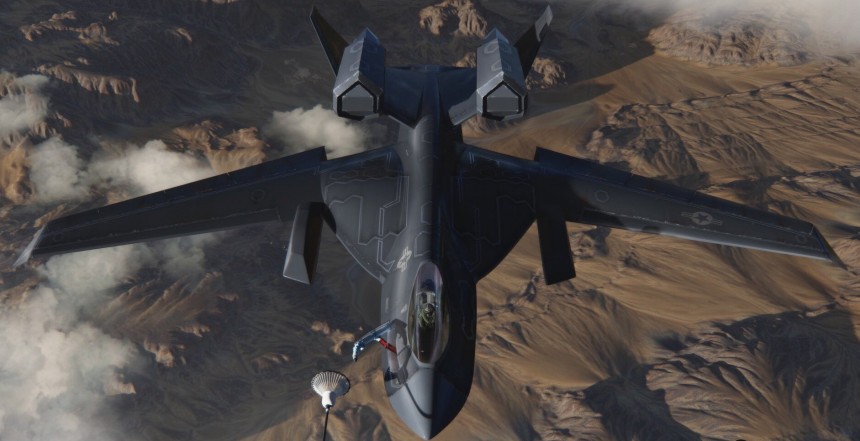If you're like us, you've probably seen a CGI graphic or two of iconic military jets like the A-10 would look like if they underwent a comprehensive redesign into stealth jets. There are even people out there who declare the best way to extend the life of the A-10's airframe is to upgrade them into stealthy ground attack jets. But if you're totally under the spell of admittedly awesome-looking CGI images, we need to bring you back down to Earth a bit.
To understand the reason why you can't just modify a legacy warbird to be stealthy, we need to familiarize ourselves with how radar stealth even works. We all generally know how the basics of how radar works. At least in an aircraft setting, a beam of electromagnetic energy is directed toward the sky, where it intersects with aerial vehicles inside the range of this energy beam. This beam is then deflected off the aircraft, where a radar receiver, often inside the same antenna as the beam emitter, picks up the incoming signal for a computer processor to identify its position in the sky relative to the radar operator.
For the first 20 years or so of ground-to-air radar, it was widely believed an aircraft's size was the key determining factor in its radar signature. It was a Russian-born Soviet physicist and mathematician called Pyotr Ufimtsev who first discovered there were actually several factors that contributed to an aircraft's ability to be detected by radar. As Ufimtsev's mathematical formulas proved, the largest contribution to an aircraft's radar cross-section was its shape rather than its size. Meaning that if an airplane was shaped in a way that deliberately reflected radar beams away from its receiver, it was possible to make a 50-foot-long fighter jet take on the radar cross-section of a small bird or even an insect.
There are a couple of different designs that engineers have integrated into modern stealth aircraft intended to refract as much of a radar's energy beam as possible. Perhaps the most vital of these, at least in regard to modern American stealth jets, is a practice called planform alignment. By which the leading edges of an airframe, from the flaps to the ailerons, the rudder, and even the shape of the pilot's cockpit, are all exactly parallel to each other at the same angle.
Without going into too much detail, radar waves that impact these angled sections tend to bounce away from radar stations rather than right back at the operator. All the missiles and bombs stealth jet is liable to carry is housed in internal weapons bays rather than on underwing pylons for this same reason, as is their autocannon. Whether Russian, American, or Chinese in origin, internal bomb bays are a trademark feature of fifth-gen stealth fighters.
Another key factor in maintaining radar stealth is the outer skin of an airplane itself. In the case of the F-117 Nighthawk, the world's first stealth fighter, a thick film of radar-absorbant tiles almost a full ton in weight was glued onto the jet's outer surfaces using aerospace-grade adhesive. Consequently, each modern stealth jet utilizes radar-absorbant coatings unique to its airframe. Limitations in a 70's era computers to calculate radar signatures ultimately resulted in the F-117's iconic "flying dorito" shape. Later advancements in this field proved smoother, rounded surfaces like those found on the Northrop Grumman B-2 Spirit and B-21 Raider could also refract radar signals, so long as their shape maintains optimal refraction characteristics.
Of course, all of this is a gross oversimplification of why radar stealth works. But none of it translates particularly well towards modifying legacy military jets like the A-10 to be stealthy. Just look at the thing! If there were a list of qualities you wouldn't want in a stealth jet, the Warthog ticks just about every single one. With its breadth of air-to-ground missiles, guided or unguided bombs, and rocket pods slung right underneath the A-10s wings and fuselage, any functioning radar suite would pick up a squadron of full-loaded A-10s with relative ease. It's partially for this reason that A-10s are only ever deployed when not just air superiority, but full-blown air dominance, is all but assured.
Modifying the A-10's airframe to house its weapons payload inside an internal bomb bay while developing a radar-absorbent coating specifically for it would be next to impossible, even on the Air Force's inflated budget. More to the point, it's pretty much impossible to make the iconic "BRRRRRRTTT" from the A-10's 30 mm GAU-8 Avenger autocannon fired from practically tree-top level remotely stealthy, let alone subtle. In fact, the prospect of a close-air support (CAS) attack jet meant to loiter over a single area for hours on end, being stealthy almost defeats the point of the aircraft in the first place.
No amount of radar stealth is going to stop a man-portable air-defense system (MANPAD) missile fired by a ground soldier screaming towards a close-air support jet when it's within visual distance of the target. Neither would changing the angle of the engine nacelles stop the A-10's turbofan engines from drawing the attention of every infrared surface-to-air missile battery for miles. Any way you slice it, a stealthy A-10 makes about as much sense as a jet-powered biplane.
Not to say that an attack aircraft with some degree of radar stealth wouldn't be useful. It's a concept that the U.S. Navy and Northrop Grumman are working on in UAV form with the X-47C attack drone. This doesn't change the fact that upgrading the A-10 platform to include radar stealth is almost assuredly a bad idea. But don't get it twisted. That doesn't mean the fan-made graphics of what the A-10 would look like if the Pentagon were dense enough to give it a try aren't still pretty darn amazing.
If you can suspend your disbelief for a few moments, we highly recommend checking the gallery above to check out some renderings that members of the aviation enthusiast community have come up with recently. The level of creativity and detail that goes into these works of art is nothing short of spectacular and needs to be appreciated. As always, credits for each piece of artwork are located in the bottom left-hand corner, so you can go check out their workspaces for yourself.
But what do you folks out there think? Would there be any positive virtue for upgrading the A-10's platform to employ a degree of radar stealth? Or is it a total pie-in-the-sky fantasy of an idea conjured up by talented artists with no grasp on how military contracts actually work? Let us know in the comments down below.
For the first 20 years or so of ground-to-air radar, it was widely believed an aircraft's size was the key determining factor in its radar signature. It was a Russian-born Soviet physicist and mathematician called Pyotr Ufimtsev who first discovered there were actually several factors that contributed to an aircraft's ability to be detected by radar. As Ufimtsev's mathematical formulas proved, the largest contribution to an aircraft's radar cross-section was its shape rather than its size. Meaning that if an airplane was shaped in a way that deliberately reflected radar beams away from its receiver, it was possible to make a 50-foot-long fighter jet take on the radar cross-section of a small bird or even an insect.
There are a couple of different designs that engineers have integrated into modern stealth aircraft intended to refract as much of a radar's energy beam as possible. Perhaps the most vital of these, at least in regard to modern American stealth jets, is a practice called planform alignment. By which the leading edges of an airframe, from the flaps to the ailerons, the rudder, and even the shape of the pilot's cockpit, are all exactly parallel to each other at the same angle.
Without going into too much detail, radar waves that impact these angled sections tend to bounce away from radar stations rather than right back at the operator. All the missiles and bombs stealth jet is liable to carry is housed in internal weapons bays rather than on underwing pylons for this same reason, as is their autocannon. Whether Russian, American, or Chinese in origin, internal bomb bays are a trademark feature of fifth-gen stealth fighters.
Of course, all of this is a gross oversimplification of why radar stealth works. But none of it translates particularly well towards modifying legacy military jets like the A-10 to be stealthy. Just look at the thing! If there were a list of qualities you wouldn't want in a stealth jet, the Warthog ticks just about every single one. With its breadth of air-to-ground missiles, guided or unguided bombs, and rocket pods slung right underneath the A-10s wings and fuselage, any functioning radar suite would pick up a squadron of full-loaded A-10s with relative ease. It's partially for this reason that A-10s are only ever deployed when not just air superiority, but full-blown air dominance, is all but assured.
Modifying the A-10's airframe to house its weapons payload inside an internal bomb bay while developing a radar-absorbent coating specifically for it would be next to impossible, even on the Air Force's inflated budget. More to the point, it's pretty much impossible to make the iconic "BRRRRRRTTT" from the A-10's 30 mm GAU-8 Avenger autocannon fired from practically tree-top level remotely stealthy, let alone subtle. In fact, the prospect of a close-air support (CAS) attack jet meant to loiter over a single area for hours on end, being stealthy almost defeats the point of the aircraft in the first place.
No amount of radar stealth is going to stop a man-portable air-defense system (MANPAD) missile fired by a ground soldier screaming towards a close-air support jet when it's within visual distance of the target. Neither would changing the angle of the engine nacelles stop the A-10's turbofan engines from drawing the attention of every infrared surface-to-air missile battery for miles. Any way you slice it, a stealthy A-10 makes about as much sense as a jet-powered biplane.
If you can suspend your disbelief for a few moments, we highly recommend checking the gallery above to check out some renderings that members of the aviation enthusiast community have come up with recently. The level of creativity and detail that goes into these works of art is nothing short of spectacular and needs to be appreciated. As always, credits for each piece of artwork are located in the bottom left-hand corner, so you can go check out their workspaces for yourself.
But what do you folks out there think? Would there be any positive virtue for upgrading the A-10's platform to employ a degree of radar stealth? Or is it a total pie-in-the-sky fantasy of an idea conjured up by talented artists with no grasp on how military contracts actually work? Let us know in the comments down below.













